Baklava Scrolls
There were so many middle eastern desserts I was wanting to try for this month's challenge, so I resolved to do two and then choose which to enter. In the end I only found time for this first one: baklava.
I have to admit to not being a huge fan of baklava. I find often they are soggy masses of sugar-dripping pastry that I don’t find as appealing as everyone else seems to. Then once I had baklava in a scroll form. I loved it. I’m not sure why it made such a difference, but I am now a fan. A big fan.
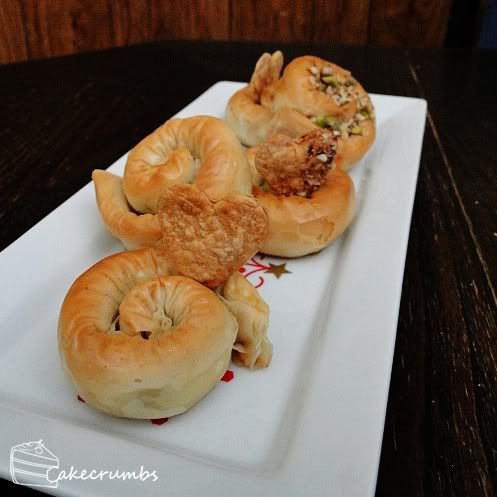
So I decided that when I made baklava for the first time, I was going to try my hand at a scroll.
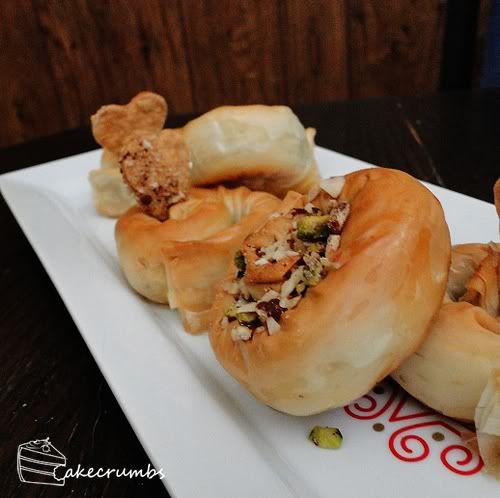
I think the appeal here has a bit to do with the lack of mess -- it's all contained in a neat parcel. But I think the best bit is the thickness of the phyllo. It uses less pastry this way, but wrapped as it is it takes on a completely different texture.
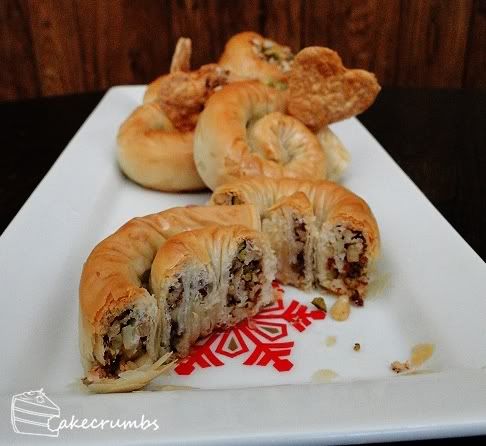
I've read many say that baklava is time consuming to make it its usual form. In my world, it's a fast process. But if you're in this school of thought, then you probably won't have the patience for this method.
Phyllo pastry is easy to work with as long as you keep it moist. I used moist paper towels as I didn't want to wet a tea towel for the job. You can use an sort of clean cloth for the job. Just remember to protect it and you won't have a problem.
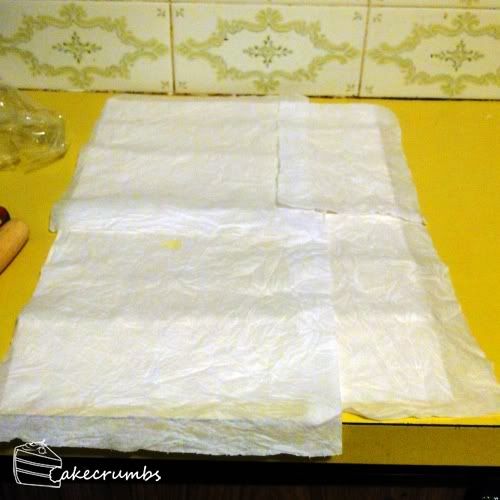
To assemble, I used a single sheet of phyllo, which I brushed with butter before folding in half. Repeat this step another two times, so you are left with a rectangle a quarter the size of the original sheet. I sprinkled a dessert spoon worth of filling along the length of one of the sides, leaving a 2cm gap at the end to finish it up neatly -- you can use your favourite baklava filling if you like, my makeshift filling recipe is below.
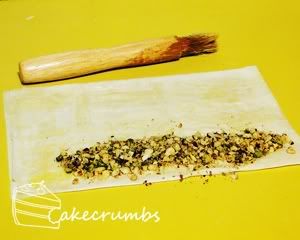
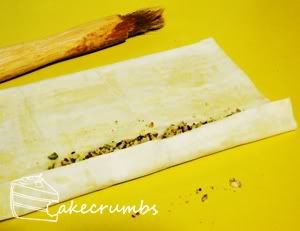
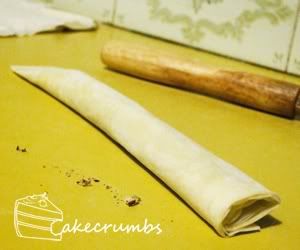
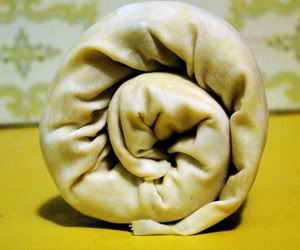
Roll it into a long tube and press the filling-less edges together. With the seam facing inwards, roll into a coil. If your edges are coming undone, brush with more butter.
I found it helpful to sit the coils upright on the baking tray with the end tucked underneath to help it 'set' while I assembled the rest. But the time I finished the batch they had begun to firm and hold their shape.
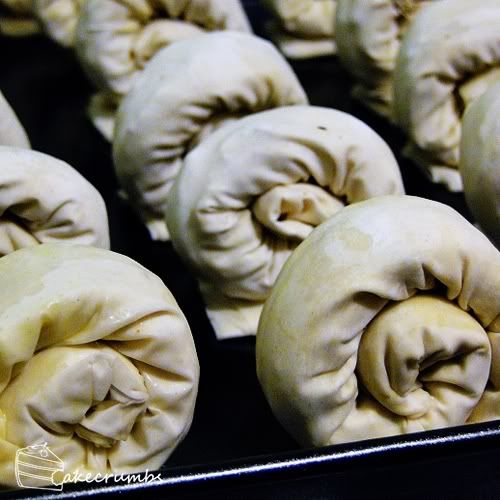
Lay the scrolls down to bake and brush with more butter.
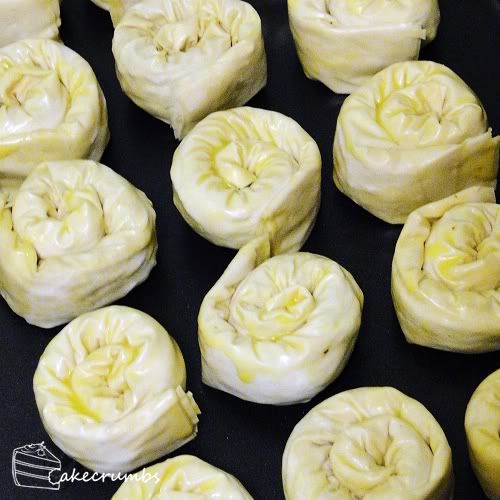
Pour the sugar syrup over them and decorate as you please, if at all.
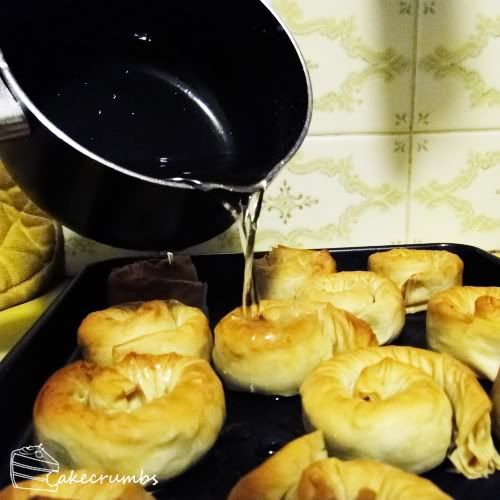
Below is roughly what I used for my baklava -- I made it up as I went along, but the premise remains the same. The beauty of is is that you don't need to be specific at all. Alter according to your tastes, substitute your preferred ingredients - it's hard to go wrong!
Baklava Filling and Syrup Recipe
Ingredients
1 pack phyllo pastry
100g butter, melted
2-3 cups of your favourite nuts (I used almonds, pistachios and pine nuts)
2 tbsp sugar
1 tsp cinnamon
2 tsp orange blossom water
1 tsp rose water
Sugar syrup
1 cup sugar
1/2 cup water
squeeze of lemon juice
Method
1. Preheat oven to 180°C/350°F
2. Process nuts slightly; add sugar, cinnamon, orange blossom water and rose water and mix.
3. Assemble as above and bake for 30 minutes, or until golden brown.
Sugar syrup
1. Combine sugar, water and lemon juice in a saucepan; stir over low heat until sugar dissolves; bring to the boil while stirring. Simmer for approximately 10 minutes. The best way to make the syrup is to eyeball it. You want it to become viscous -- you don't want to caramelise it the same way you would when making toffee.
2. Pour hot syrup over pastry. Allow to cool.
I have to admit to not being a huge fan of baklava. I find often they are soggy masses of sugar-dripping pastry that I don’t find as appealing as everyone else seems to. Then once I had baklava in a scroll form. I loved it. I’m not sure why it made such a difference, but I am now a fan. A big fan.

So I decided that when I made baklava for the first time, I was going to try my hand at a scroll.

I think the appeal here has a bit to do with the lack of mess -- it's all contained in a neat parcel. But I think the best bit is the thickness of the phyllo. It uses less pastry this way, but wrapped as it is it takes on a completely different texture.

I've read many say that baklava is time consuming to make it its usual form. In my world, it's a fast process. But if you're in this school of thought, then you probably won't have the patience for this method.
Phyllo pastry is easy to work with as long as you keep it moist. I used moist paper towels as I didn't want to wet a tea towel for the job. You can use an sort of clean cloth for the job. Just remember to protect it and you won't have a problem.

To assemble, I used a single sheet of phyllo, which I brushed with butter before folding in half. Repeat this step another two times, so you are left with a rectangle a quarter the size of the original sheet. I sprinkled a dessert spoon worth of filling along the length of one of the sides, leaving a 2cm gap at the end to finish it up neatly -- you can use your favourite baklava filling if you like, my makeshift filling recipe is below.




Roll it into a long tube and press the filling-less edges together. With the seam facing inwards, roll into a coil. If your edges are coming undone, brush with more butter.
I found it helpful to sit the coils upright on the baking tray with the end tucked underneath to help it 'set' while I assembled the rest. But the time I finished the batch they had begun to firm and hold their shape.

Lay the scrolls down to bake and brush with more butter.

Pour the sugar syrup over them and decorate as you please, if at all.

Below is roughly what I used for my baklava -- I made it up as I went along, but the premise remains the same. The beauty of is is that you don't need to be specific at all. Alter according to your tastes, substitute your preferred ingredients - it's hard to go wrong!
Baklava Filling and Syrup Recipe
Ingredients
1 pack phyllo pastry
100g butter, melted
2-3 cups of your favourite nuts (I used almonds, pistachios and pine nuts)
2 tbsp sugar
1 tsp cinnamon
2 tsp orange blossom water
1 tsp rose water
Sugar syrup
1 cup sugar
1/2 cup water
squeeze of lemon juice
Method
1. Preheat oven to 180°C/350°F
2. Process nuts slightly; add sugar, cinnamon, orange blossom water and rose water and mix.
3. Assemble as above and bake for 30 minutes, or until golden brown.
Sugar syrup
1. Combine sugar, water and lemon juice in a saucepan; stir over low heat until sugar dissolves; bring to the boil while stirring. Simmer for approximately 10 minutes. The best way to make the syrup is to eyeball it. You want it to become viscous -- you don't want to caramelise it the same way you would when making toffee.
2. Pour hot syrup over pastry. Allow to cool.